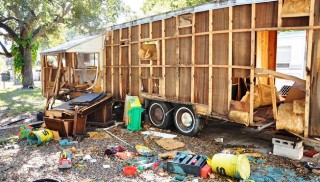|
Article Courtesy of The Tampa Tribune By Mike Salinero Published January 11, 2011
GIBSONTON - Here in Tommy Layton's neighborhood, abandoned
houses are like pockets of cancer, eating away at property values and
residents' quality of life.
Layton, 50, owns a small roofing business and has lived in the working-class neighborhood for 22 years. He remembers a quieter, rural Gibsonton, once known as a retirement haven for carneys and circus performers. Growth brought cookie-cutter subdivisions and Walmart to Gibsonton. The housing bubble and bust brought foreclosures and empty homes. Owners walked away from several foreclosed homes on Layton's block, leaving the buildings and property defenseless prey for criminals, looters and vandals.
Code Enforcement put 159 houses on the condemned list during the last fiscal year ending Sept. 30. That's up from 82 condemnations the previous year. As of last week, 60 of the 159 houses had been torn down. The rest are either awaiting demolition, pending further evaluation or in the judicial process. A house is flagged for condemnation if Code Enforcement determines that needed repairs exceed 50 percent of the value of the property. The final decision to condemn the building is made by the Code Enforcement director, a building official from the Planning and Growth Management department and the fire marshal. Once the decision is made, the county conducts a title search to see if there are liens on the property. Then the county notifies the owners, who have 15 days to appeal the decision to the county commission. In some cases, there are financial or personal reasons the owners have not been able to care for the property. "A lot of people want to repair the structure," FerDon said. "We work with them as long as the property is kept secure and the lawn is cut." The process, starting with the phone call from a concerned citizen to final demolition, can seem interminable to nearby residents. For more than two years, a house sat empty two doors down from Layton's house on Estelle Street. Layton said drug dealers set up shop in the house, and the yard was trashed by illegal dumpers. Mold covered the interior walls and the lawn grew as high as a man's shoulders. Layton started mowing the yard so it wouldn't look so bad. The house was on Code Enforcement's priority list, but it took nearly a year and a half to demolish it. Layton now looks at the empty lot as a victory of sorts for a neighborhood that sorely needed one. It just took too long. Layton blames the banks that he says fail to keep up properties after they foreclose. "I feel strongly they need to step up to the plate and protect their assets," he said. But banks only take possession after the foreclosure has worked its way through the courts. That can take from one to two years because of the judicial backlog, said Alex Sanchez, president of the Florida Bankers Association. "We do not have the legal right to enter into that home until the foreclosure process has been completed legally and we get title," Sanchez said. "In some counties, that takes nine months; in some counties it's 28 months because of the backlog." Bill Langford, Code Enforcement's countywide supervisor, agreed that the increasing numbers of abandoned houses is due in part to owners who walk away or fight foreclosure. But the banks bear some blame, he said, for allowing empty houses to deteriorate. Though they can't enter the houses, the banks could pay to have the lawns mowed, he said "I'm assuming the banks are overwhelmed," Langford said. "They've got to become more active because we're ending up with more demolitions and no one wins in those situations." The county hopes to reduce the condemnation backlog this year with the help of federal grant money. Last fiscal year, code enforcement spent $116,000 condemning and demolishing houses. This year, the agency has nearly $300,000 to work with, including $195,000 in federal stimulus money. The county formed a team of five investigators to speed up the process and concentrate on the worst cases. Meanwhile, Layton is waiting for action on another house a block away from his house, where trash litters the yard and a travel trailer in the back has been stripped of its aluminum siding. The house has been empty for more than a year. "By the time the bank gets them," Layton said, "they're not worth selling." |
